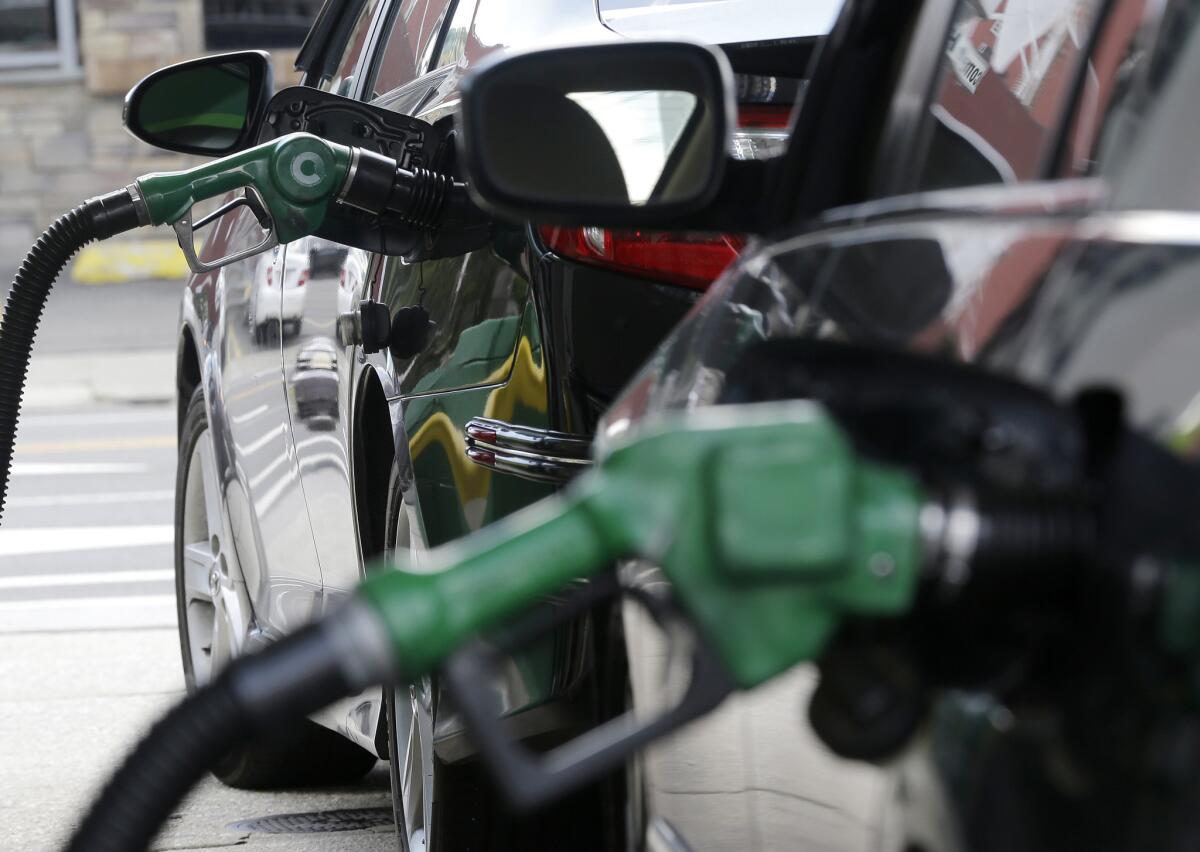EPA moves fast on mpg regs as inauguration draws near

Reporting from San Francisco — Despite protests from the auto industry, the Environmental Protection Agency wants to keep strict gas mileage targets in place and is trying to fast-track those standards before President-elect Donald Trump takes office in January.
In a proposal on Wednesday, the agency said it continues to want a company’s fleet of new cars and light trucks to range between 49.9 and 53.3 miles per gallon by 2025, on average, depending on the mix of cars and trucks sold. That amounts to about 40 mpg in real-world driving and is a significant increase from the 24.8 mpg that cars sold in October get.
The EPA had until April 2018 to finalize its fuel economy standards, but its decision to issue a proposal this week was seen by some as a hasty attempt to get those standards on the books before Trump’s Jan. 20 inauguration. The proposal is now open for public comments until the end of the year.
Fuel economy has been a thorny issue between the federal government and carmakers. President Obama first introduced the plan in 2012, when gas prices were significantly higher. Now gas is hovering at about $2 a gallon nationally, and car buyers have shifted their preferences toward larger and less fuel-efficient SUVs and trucks.
So carmakers have pushed for the EPA to reconsider its fuel efficiency targets, and were hoping for a rollback. Instead, Wednesday’s proposal angered several auto groups. The Alliance of Automobile Manufacturers called the EPA move “an extraordinary and premature rush to judgment.”
Peter Welch, president of the National Automobile Dealers Assn., said: “Washington today decided to make new cars and trucks more expensive for America’s working men and women.”
On the other side, environmental and consumer groups were ecstatic.
“What’s not to like about a plan, agreed to by automakers, that cuts oil use, saves money at the pump and reduces pollution?” said Dan Becker, director of the Safe Climate Campaign.
The proposal has been years in the making.
In 2011, in the wake of the federal auto industry bailout, the Obama administration and industry executives agreed to lift mileage goals from 30.2 mpg for cars and 24.3 mph for light trucks to a goal of 54.5 mpg across their fleets by 2025. That figure was reduced in July to 50.8 mpg. Because of testing variations, experts say the mpg number that shows up on a window sticker is about 20% to 30% lower.
The agreement required a “mid-term review” where technological progress and consumer demand would be considered to determine whether the goal was reachable.
Now the EPA is saying yes, it is reachable. In its lengthy “proposed determination” on Wednesday, the agency explained that while it was required to make a final determination “no later” than April 1, 2018, nothing stops it from moving sooner.
Once the public comment period is over Dec. 31, the agency could issue its final ruling.
“I can’t imagine there won’t be litigation that says ‘That’s not long enough,’” said Patrick Michaels, director of the Center for the Study of Science at the Cato Institute, a free-market think tank.
He’s not sure though — so far, no one is — how Trump or his incoming administration will react.
“They have said they want to rein in the EPA; they’ve been crystal clear on that,” he said. “This is a real interesting litmus test for the new administration.”
It’s also unclear whether automakers will pressure Trump to loosen such regulations. Many have been retooling their manufacturing plans in anticipation of the ramp-up and may be too far along to scale back.
And, some analysts say, global markets are pushing automakers toward higher-mileage vehicles anyway.
“Automakers are global, and markets outside of the U.S. – as well as California – are demanding more fuel-efficient and lower-emitting vehicles,” said Michelle Krebs, senior analyst at Autotrader. “Automakers will still be on the hook to develop and produce these vehicles and will need economies of scale to make them profitable.”
Krebs notes that if the new administration gutted the standards, the administration after that might add a new set, making planning difficult.
Furthermore, the regulations were written to give the so-called Detroit 3 automakers more flexibility in meeting the standards with their large trucks and SUVs.
Upending the standards could also risk the return of patchwork regulations around the U.S., analysts said.
The mileage standards were first created by Congress in 1975. California later set tougher standards for vehicles sold in the state, which forced automakers to customize their California cars and trucks.
To their relief, the standards were harmonized into national regulations in 2009. But California could go its own way again.
The Obama EPA’s move “provides solid support for continuation of the single national program to produce a new generation of clean vehicles to address the air quality challenges facing California and other states,” California Air Resources Board Chairwoman Mary D. Nichols said.
Whatever happens with federal mileage standards, California’s Zero Emission Vehicle program is likely to remain in place. It requires that 15% of new vehicles sold in 2025 be zero emission — practically speaking, that means all-electric cars.
More to Read
Inside the business of entertainment
The Wide Shot brings you news, analysis and insights on everything from streaming wars to production — and what it all means for the future.
You may occasionally receive promotional content from the Los Angeles Times.











